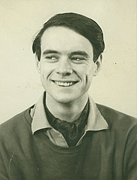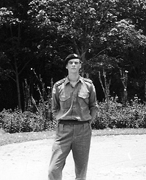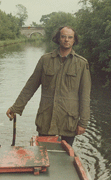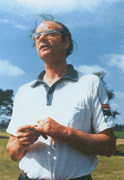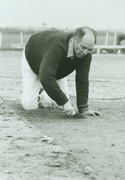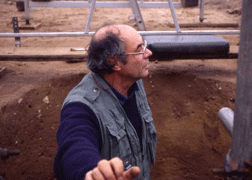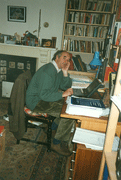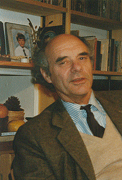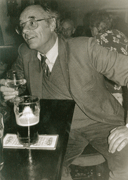Curriculum Vitae
Born 8 July 1941 in Glasgow, Scotland
BSc [General Science] University of London (external, 1968)
Diploma in Anglo Saxon Archaeology, Durham University (1973)
Fellow of the Society of Antiquaries of London (1981) (Vice President 2002)
Founder-member and secretary of the Institute of Field Archaeologists (1982)
Fellow of the Royal Asiatic Society (1993)
Fellow of the Society of Antiquaries of Scotland (1994)
Corresponding Member of the German Archaeological Institute (2002)
| Principal appointments | |
| 1959-1972 | Army officer in Royal Tank Regiment |
| 1968-1971 | Adjutant, 4th Royal Tank Regiment |
| 1971-1972 | Ministry of Defence. Retired in rank of Captain |
| 1973-1974 | Postgraduate student, University of Durham |
| 1974-1977 | Director, West Midlands Rescue Archaeology Committee (WEMRAC) |
| 1977-1986 | Director, Birmingham University Field Archaeology Unit (BUFAU) |
| 1983-2005 | Research director, Sutton Hoo Research Trust |
| 1986-2008 | Professor of Archaeology, University of York (1986-1996 Head of Department) |
| 1992- | Director, Field Archaeology Specialists Ltd (1999- Chairman) |
| 1994- | Research director, Tarbat Discovery Programme |
| 2001-2002 | Director, Centre for Medieval Studies, University of York |
| 2003- | Editor, Antiquity |
Martin spent his childhood in Scotland, India, Hong Kong and England, then became an army officer (1959 to 1972), seeing active service in the Near and Far East. First educated as a scientist, he turned to archaeology, studying Anglo-Saxon art, archaeology, history and literature with Professor Rosemary Cramp at Durham. This led to a study of Anglo-Saxon illustrations of artefacts, focusing on BL Harley ms 603, later published in Archaeologia 108 (1986).
Between 1974 and 1986 Martin worked as a field archaeologist, first as free-lance and then from Birmingham University, undertaking a wide range of projects, many of them investigating early medieval towns in England. A DGRST fellowship in 1982 allowed him to explore urban archaeology in France (see 'Forty French towns', Oxford Journal of Archaeology 2, 1983). Further fieldwork and excavations led him to Italy (Manerba and Castelseprio in particular) and Algeria (Achir). This work was published in a number of papers and summarised in books such as Underneath English towns (1987), Arguments in stone (1993) and Archaeological value and evaluation (2003).
In 1983 Martin was appointed to direct a new campaign of research at Sutton Hoo. Over a hectare was excavated during the 1983-1993 campaign, which pioneered a (then) innovative approach to evaluation, project design and integrated fieldwork. Seven burial mounds were examined including the intact burial under Mound 17 and its accompanying horse-burial. The excavations also brought to light two execution cemeteries. The publications stemming from this campaign argue that Sutton Hoo represented a short-lived attempt to create a distinctive kingdom in East Anglia, in alliance with Scandinavia and in opposition to the Frankish Christian power block. A multi-author review of the seventh century AD in north-western Europe (The Age of Sutton Hoo, Carver (ed.) 1992) preceded a popular synthesis of the campaign in 1998 (Sutton Hoo: burial ground of kings?). The full report was published in 2005 (Sutton Hoo: a seventh-century princely burial ground and its context).
In 1994 Martin began a new research project based around the 6-10th century Pictish settlement and monastery at Portmahomack on Tarbat Ness, Easter Ross in Scotland. As at Sutton Hoo, research at Tarbat has illustrated the changing ideology and allegiance of the early medieval community there, contributing to crystallise ideas on conversion (see The Cross goes North, Carver (ed.) 2003). The site work was completed in 2007, and a preliminary account published in 2008 (Portmahomack: monastery of the Picts). Tarbat also features in a popular account of the Picts (Surviving in Symbols, 1999). Work on the full research report is in progress.
Appointed Professor of Archaeology at the University of York in 1986, Martin was Head of Department from 1986 to 1996. During this time the Department built on its strength in medieval archaeology and began an expansion (later much developed) into areas of prehistory and bioarchaeology; it established a graduate school and moved to the heart of the city of York at King's Manor. Martin was also Director of the Centre for Medieval Studies at York in 2001-2002.
Martin has served on a number of academic bodies in Britain: on the archaeology panel of the Arts and Humanities Research Board in 1996-1999; the AHRC Subject Review panel (2005); the AHRC Postgraduate awards panel (2005-2007); the Council and Executive Committee of the Society of Antiquaries of London (1999-2006, the last three years as Vice-President). He has become increasingly active beyond the confines of Britain, teaching courses in Italy and Denmark, co-organising the Medieval Europe conference series, serving on a Danish Government research panel in 1996, and advising on excavation proposals at Gamla Uppsala (Sweden) in 2003. In 1999 he was appointed to the Council of the Discovery Programme, Republic of Ireland, and the archaeology panel of the Irish Humanities Research Board. He is currently a panel member for the Irish Research Council for the Humanities and Social Sciences and of the European Research Council.
Martin has been Editor of Antiquity since 2003 and has been reappointed for a second tour in 2007 (until 2012). His passion for communicating archaeology at all levels - at countless meetings, from international conferences to local and student archaeological societies - has also led to a number of radio and TV broadcasts (BBC2 Sutton Hoo series and other British, American and German productions).
In the near future the publication of the Anglo-Saxon cemetery at Wasperton (Warks) and the report on urban evaluation and excavation campaigns at Stafford will appear. These reports, together with the Tarbat research report, the editing of substantial early medieval collections, the preparation of the 2010 Rhind lectures (Edinburgh), books on field and world archaeology, further research and publication projects in Scotland, the editing of well over 1000 pages of Antiquity per year, and continuing to teach undergraduates at York will ensure that 'retiring' from the post of Professor at York is anything but retirement.
